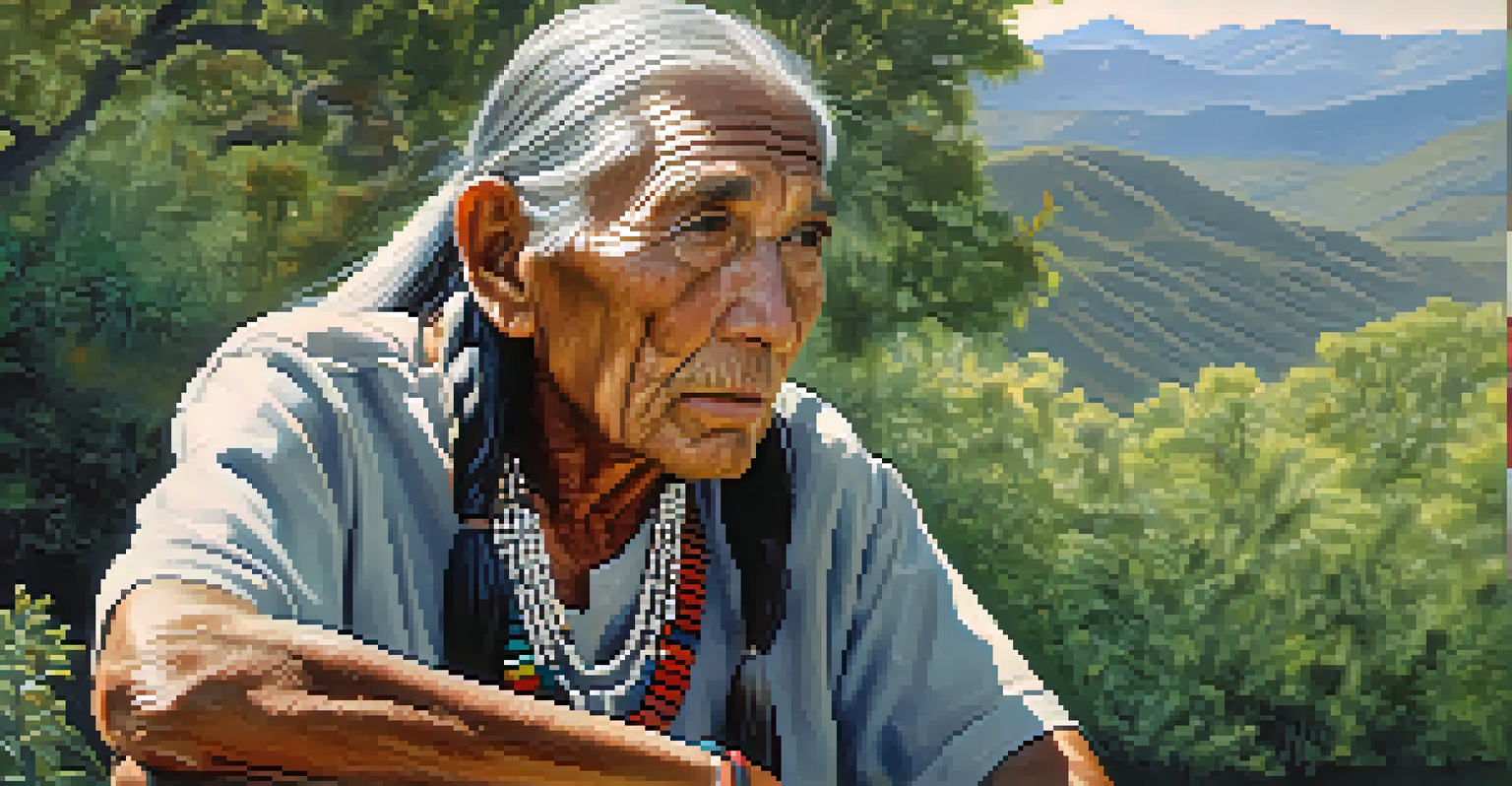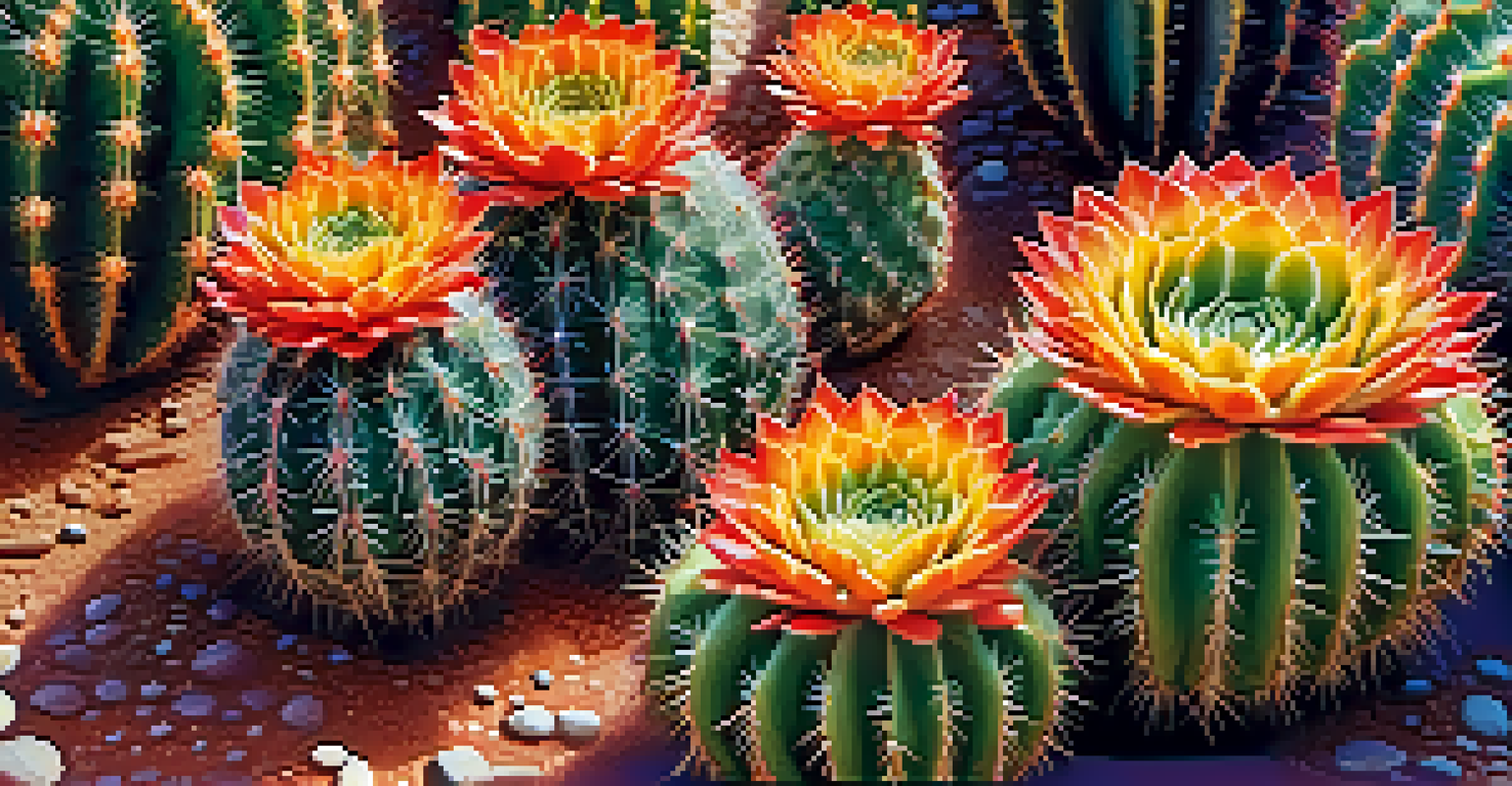Understanding Peyote Use in Native American Spirituality

What is Peyote and Its Cultural Significance?
Peyote is a small cactus with psychoactive properties, primarily found in Mexico and the southwestern United States. For many Native American tribes, it holds deep cultural and spiritual significance, often used in sacred ceremonies. The cactus contains mescaline, a compound that induces altered states of consciousness, allowing users to explore spiritual realms.
Psychedelics can help us reconnect with our true self and our purpose in life.
Throughout history, peyote has been integral to various indigenous rituals, symbolizing a connection to the divine and nature. It is not merely a drug; it is a tool for healing, self-discovery, and community bonding. Many tribes view the peyote ceremony as a way to communicate with ancestors and seek guidance.
In essence, peyote represents more than just a plant; it embodies a tradition that fosters spiritual growth and cultural identity among Native American communities. Understanding its significance is crucial to appreciating the broader context of its use.
Historical Background of Peyote in Native American Culture
The use of peyote dates back thousands of years, with evidence suggesting its use in religious practices by indigenous peoples in North America. Various tribes, including the Huichol and the Lakota, have utilized peyote for both medicinal and spiritual purposes. This rich history has shaped the way peyote is perceived and integrated into cultural practices today.

In the early 20th century, the peyote religion began to take form as organizations like the Native American Church emerged. This movement sought to preserve and promote the spiritual use of peyote amidst growing external pressures and legal challenges. The church provides a structured framework for peyote ceremonies, emphasizing respect and reverence for the plant.
Cultural Significance of Peyote
Peyote is deeply rooted in Native American traditions, serving as a sacred tool for spiritual healing and community bonding.
Despite facing legal scrutiny, peyote remains a protected substance for religious use in many Native American communities. This legal acknowledgment is a testament to its importance in preserving cultural heritage and spiritual practices.
Peyote Ceremonies: Structure and Purpose
Peyote ceremonies typically involve a gathering of community members who come together to partake in the sacramental use of the cactus. These rituals often include singing, drumming, and prayer, creating a sacred atmosphere that fosters connection and introspection. The structure of these ceremonies may vary from tribe to tribe, but the underlying purpose remains the same: spiritual healing and communal bonding.
The use of peyote is not just a rite; it's a way to communicate with the divine and to heal.
During the ceremony, participants consume peyote, which induces visionary experiences that are believed to facilitate communication with the spiritual world. These altered states are seen as opportunities for personal reflection, healing, and guidance. Elders or spiritual leaders often guide the ceremony, ensuring that participants approach the experience with respect and intention.
Ultimately, peyote ceremonies serve as a means to reinforce cultural identity and spiritual beliefs. They provide a safe space for individuals to explore their inner selves and seek wisdom from the universe.
The Role of Elders in Peyote Practices
Elders play a crucial role in the peyote tradition, serving as guides and mentors during ceremonies. Their wisdom and experience are invaluable, ensuring that rituals are conducted with respect and cultural integrity. Elders often share teachings about the significance of peyote, helping younger generations understand its importance within their cultural context.
In many cases, elders have spent decades participating in and leading peyote ceremonies, gaining insights that transcend personal experience. They are often regarded as spiritual leaders, providing counsel and support to community members. This intergenerational knowledge sharing is vital for the preservation of traditions and practices surrounding peyote.
Role of Elders in Ceremonies
Elders guide peyote ceremonies, sharing their wisdom and ensuring cultural integrity while fostering intergenerational knowledge.
By fostering a deep connection to their cultural heritage, elders help instill a sense of responsibility in younger members of the tribe. This continuity strengthens the community and ensures that the sacred use of peyote remains a vibrant aspect of their spiritual lives.
Healing and Therapeutic Uses of Peyote
Beyond its spiritual implications, peyote has been recognized for its potential therapeutic benefits. Many participants report experiencing profound emotional and psychological healing during ceremonies, making it a valuable tool for those struggling with trauma or addiction. The introspective nature of the peyote experience can lead to significant personal revelations and healing.
Research into the therapeutic aspects of peyote and mescaline has gained momentum in recent years, with studies exploring its effects on mental health issues. This growing interest highlights the need for a deeper understanding of peyote's role in healing, both in traditional and modern contexts. The combination of spiritual growth and psychological healing can create a holistic approach to wellness.
In this way, peyote serves as a bridge between ancient practices and contemporary therapeutic approaches. As more people recognize its potential, there is a growing conversation about the importance of cultural sensitivity and respect for indigenous practices.
Legal Issues Surrounding Peyote Use
The legal status of peyote remains a complex issue, particularly in light of its sacred use among Native American tribes. While the American Indian Religious Freedom Act allows for the religious use of peyote, there are still challenges and restrictions that can vary by state. This legal framework is essential for protecting the rights of indigenous peoples to practice their traditions.
In recent years, there have been ongoing debates about the implications of peyote's legal status, especially as interest in psychedelic substances grows. Advocates argue for the need to respect traditional practices while navigating contemporary legal landscapes. It raises important questions about cultural appropriation, consent, and the responsibility of non-indigenous individuals in engaging with peyote.
Therapeutic Benefits of Peyote
Peyote offers potential emotional and psychological healing, bridging ancient practices with modern therapeutic approaches.
As discussions continue, it's vital to approach the topic with sensitivity and a genuine understanding of its cultural significance. Legal protections must honor the traditions of those who have used peyote for centuries, ensuring that its sacred use is respected and preserved.
The Future of Peyote in Native American Spirituality
Looking ahead, the future of peyote in Native American spirituality is both hopeful and challenging. As younger generations reconnect with their cultural roots, there is a renewed interest in peyote ceremonies and traditions. This revival promises to strengthen community bonds and preserve essential aspects of their heritage.
However, the sustainability of peyote itself poses a significant concern. Overharvesting and environmental changes threaten the availability of this sacred plant, prompting discussions about responsible use and conservation efforts. Ensuring that peyote remains accessible for future generations is a critical issue that communities must address together.

Ultimately, the future of peyote will depend on the collective efforts of Native American communities to protect their traditions while adapting to contemporary challenges. The ongoing dialogue about its significance will continue to shape the relationship between spirituality and the natural world.